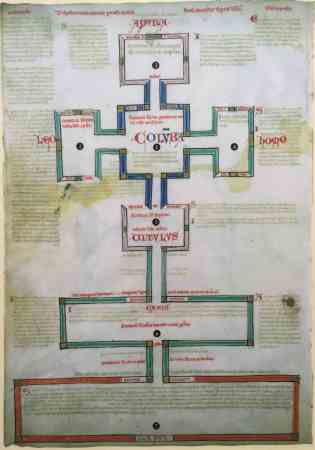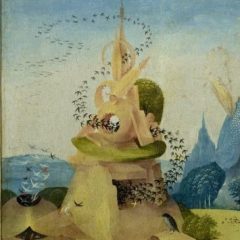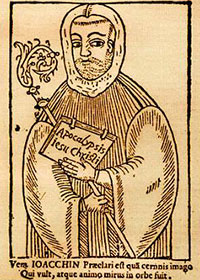
Liber Figurarum, tav. XII
A parallel reading of Divine Comedy and Joachim of Fiore’s works is bound to be extremely fruitful. Readers are quite accustomed to inquire into the political aspects of Dante’s masterpiece or into the stylistic and even moral side of it, but once they read it through the watermark of Joachim’s inspirations, the Commedia glows with a brighter mystery and rejects to be related to any ideological purpose.
I recently found extremely interesting sparks about such comparison between Joachim of Fiore and Dante Alighieri in a very well documented work by Antonio Crocco: Gioacchino da Fiore e il gioachimismo; but, before going into deep about it, I would rather focus on Crocco’s general attitude and explain the reasons why I cannot approve it at all.
In relation to what Joachim wrote in Expositio super Apocalypsim on his own understanding of St. John’s Revelation and the whole of the Bible[1], Crocco remarks: “The ‘revelatio’ Joachim is talking about, using the typical language of the mystics who often tend to find the cause of their meditational outcomes and spiritual intuitions in a divine enlightenment, must not be conceived, technically, as a biblical supernatural revelation, but as a mystic-subjective illumination, in other terms, as the intuition of a truth reached by a constant meditation on the Scriptures”[2].
Let’s try to understand. Being Joachim a contemplative monk who consecrated his life to the comprehension of the divine plan and who brought to light extremely profound aspects of such plan, whom could he ever thank for such capacity and skill, if not the heavenly Providence itself? If such a ‘mystic’, as Crocco defines him, meant to live in agreement with the divine will, whatever it cost, how could he see his comprehension of the Scriptures as a result of a ‘mystic-subjective illumination’? As we can see, Crocco’s words express that sort of modern mentality which completely misunderstands the rich and fertile inheritance that the traditional spiritual knowledge has bequeathed to us. The so called historical materialism has not only dumped whatever has to do with transcendence, labelling it superstructure, but on top it came to build up a mental cage after another in which the real meaning of the spiritual intuition came to be completely forgotten.
Now, was Crocco a materialist scholar or not, what I am talking about here is something that has literally overwhelmed the western culture since quite a long time, together with its universities, its press and whatever such culture allowed standing. We can depict such mentality as the infernal city of Dis which, especially during the Sixties and the Seventies, raised his walls against any traditional and spiritual knowledge while its defenders stood proud on top claiming to be able to show mystics and prophets all of their mistakes and naivety!
If we really focus on such mentality, we can clearly realize what an absurdity it has been.
I would find all of these things of no importance, if I did not know that such materialist and anti-spiritual attitude is now more alive and widespread than ever. It aims at reducing everything to a human and organic matter, trying to destroy in the meantime all bridges to Heaven completely forgetting how limited human knowledge is and how boundless the Heavenly one, as we read in Psalm 146: “He determines the numbers of the stars; he gives to all of them their names. Great is our Lord, and abundant in power; his understanding is beyond measure”.
I shall return further on this, when it comes to talk about the idea of destiny and Grace according to Dante Alighieri.
Another flaw in Crocco’s work is the underestimation of the legendary aspect concerning Joachim of Fiore. Although legends can be quite misleading and fascinate us with captivating but false plots, as Crocco holds, notwithstanding they often hide meaningful sides of the medieval intellectual life and, if we dig in the right direction, they can lead us to a deeper knowledge of the Middle Ages which is to be considered, despite all of its controversies and oddities, the last European traditional age.
Crocco, by instance, steadily holds that the ‘legendary’ dispute occurred between Peter Lombard and Joachim of Fiore is utter swindle. Despite of this, it is a fact that the Lombard-Parisian Scholar, considered one of the founders of Scholastic philosophy, and the Calabrese abbot devoted their lives to completely different kinds of theological researches. Peter committed himself in clarifying the Catholic dogmas and rituals, especially in favour of the new generation clergy, while Joachim, who often kept himself far from any institutional environments, attempted an overview of the two Testaments with a particular concentration on St. John’s Revelation.
Furthermore, regardless of the fact that Peter Lombard’s teaching on Trinity was admitted as an official Catholic doctrine, while Joachim’s first work on the same subject was not accepted and later on went lost, what we mean to show here is that, during the 12th and 13th centuries, two different branches came sprouting out of the Church tree: the first one more institutional and academic and the second one more contemplative and secluded.
As we can see, the legend reporting the clash between the two is nothing but an exaggeration of a real distinction between the official church and the so-called spiritualists, nevertheless it must be remembered that we find both Peter and Joachim in the Sun Heaven of Dante’s Paradise, together with all the main Catholic theologians where, not by chance, the Lombard stands next to St. Thomas Aquinas while Il Florense next to St. Bonaventure from Bagnoregio.
Beside all of this criticizing against Crocco’s work, we must also highlight its merits. First of all, it is of the highest importance the consonance he finds between Dante’s Greyhound and Joachim’s Canis, being the first one of the main allegories of Inferno’s first canto and the latter one part of the Tavola XII in the Liber figurarum. According to Crocco, the two images should be interpreted as an allusion to a renewed and purified clergy and, at a higher level, to the Universalis Sanctus Pontifex long expected by the spiritualists throughout the 13th century which was finally, although only temporarily, personified by Celestine V. The greyhound character could also be read through the Angel of Revelation 7, who invites all the other Angels not to destroy the earth before all believers have received the holy sign: according to Crocco, Dante took this idea from Joachim’s Liber Concordiae Novi ac Veteris Testamenti[3].
Such interpretation proposed in Goacchino da Fiore e il gioachimismo seems to be extremely efficacious, though it cannot not be forgotten that Dante’s verses must always be read in accordance to different levels of interpretation, as he himself reminds us in various occasions.
A further fascinating and well-founded interpretation by Crocco is the one concerning Beatrice seen as the Ecclesia spiritualis, the bride waiting for the Christ-groom. Such symbolism can be found in both Gospels and St. John’s Revelation. According to Crocco, Beatrice is clearly depicted as the personification of the spiritual church and Christ’s bride in Purgatory cantos XXIX and XXX where, in a symbolic wedding procession rich in apocalyptic symbolism, Beatrice is praised even by these verses from the Song of Solomon: “Come with me from Lebanon, my bride”[4].
Crocco’s interpretation of the Beatrice character – whose beauty “transcends”, “si trasmoda”, as it is said in Paradise 30, 19 – can surely be brought to a higher and deeper level, allowing us a reflection on the inner meaning and role of Beatrice in the Divine Comedy. Throughout Dante’s masterpiece, she seems to personify that particular spiritual intuition which is able to go beyond any rational evidence and statement.
Such aspect of Beatrice is clearly declared in these words:
“’T is Beatrice, who thus from good to better
conducts one with such swiftness, that her act
extendeth not through time” [5].
Does it not look like the description of that soul’s faculty which is not involved in the temporal dimension and is able to reach the spiritual fullness? This also seems the reason why Beatrice can clearly explain the very beginning of the transcendental world and how Angels themselves were born:
“I tell, but do not ask,
what thou art fain to hear, for I have seen it
where every Where and every When is fixed.
Not for the gain of good unto Himself,
which is not possible, but that His Splendor
might in resplendency declare ‘I AM,’
in His Eternity, outside of time,
out of all limits else, the Eternal Love,
as pleased Him, in new loves disclosed Himself.
Nor yet ere this did He remain inert,
for neither after nor before, occurred
God’s going to and fro upon these waters” [6].
It is quite worthy to recall here that many angelical interventions all along the Comedy seem to take inspirations, like a prefiguration of the passage just quoted, from the very start of Genesis where it is said that the Ruah of Elohim swept over the Abyss. The Angel who goes down to hell to open a passage through the city of Dis “with dry feet, was passing over Styx”[7]. while, in Purgatory, another Angel is depicted as “a light which o’er the sea so swiftly moved, that no flight is as rapid as its motion”[8].But how can Beatrice-Upper soul know all of these things? How was she allowed to know about super-rational mysteries such as the Divine Fullness and the birth of the Angelical Intellects?
At this point, it must be said that many of Beatrice’s concerns seem to deal with the so called Unio Mystica which had to be one of the most meditated transcendental theme during the Middle Ages, though not by Christian authors only.
Dante’s reflection on the Angelical Intellects turns out to be an investigation on the nature of Grace allowed to our spiritual soul, as we can realize by giving heed to these words:
(…) Those whom thou here
beholdest, modest were, and recognized
themselves as from that Goodness sprung, which apt
had made them for such great intelligence.
And therefore by illuminating Grace,
and by their merit, was their sight so raised,
that now a full and steadfast will is theirs.
Nor would I have thee doubt, but be assured,
that to receive God’s Grace is meritorious,
according as affection opens to it [9].
In the original Italian version sight so raised is ‘viste essaltate’ which would sound better if translated as ‘exalted sights’. An exalted sight and a full will actually are the main qualities of an enlightened soul given up to contemplation. In relation to this, Dante reminds us that there is no difference between the Grace reached and the Grace allowed, since, as we were implying earlier about Joachim’s spiritual intelligence, we just read above that: “to receive God’s Grace is meritorious, according as affection opens to it”.
In conclusion, I would like to focus on one last echo from Joachim’s works in Dante’s Comedy: we find it at the very end of Paradise:
Within the Lofty Light’s profound and clear
subsistence there appeared to me three Rings,
of threefold color and of one content;
and one, as Rainbow is by Rainbow, seemed
reflected by the other, while the third
seemed like a Fire breathed equally from both [10].
Joachim’s picture Dante seems to take inspiration from is the Tavola XI from the Liber Figurarum. It actually depicts three circles symmetrically put next to each other containing four capital letters which should be a Latin version of the Jewish Tetragrammaton. Crocco highlights that, on his turn, Joachim could have taken inspiration for his picture from Pedro Alphonsi, a Jew converted to Catholicism. The possible relations between the Calabrian abbot and the Jewish medieval culture has been already debated and someone even detected it as an irregular element in the Joachimite background. However, it is a matter of fact that the reflection on the nature of soul and the impossibility for the common Logic to explain the highest havens a spiritual soul can reach affected the whole Middle Ages intellectual life. What Christianity named Uno Mystica and the Hebraism Devekuth is one of those spiritual aspects Dante mostly focused on as we confirmed by Beatrice’s words above. Actually, he himself had written in his first work, Vita Nova: “The heavens that have no other defect/ but lack of her”, disclosing how he would have transcended all the limits of the common logical knowledge.
NOTES
[1] Expositio in Apoclypsim, Ed. Venetiis 1517, 2 f 39v: “Ergo in supra scripta nocte… circa medium (ut opinor) noctis silentium, subito mihi meditandi aliquid, quadam mentis oculis intelligentiae claritate percepta, de plenitudine libri huius (Apocalypsis) et tota veteris ac novi Testamenti concordia revelatio facta est”.
[2] Gioacchino Da Fiore e il gioachimismo, Liguori Editore, Napoli 1976, p. 15, note 18.
[3] St. John’s Revelation 7, 2. Cfr. Joachim of Fiore, Liber concordiae Novi ac Veteris Testamenti IV, 31.
[4] Song of Salomon 4, 8; Purg. XXX, 11.
[5] Par. 10, 37-39. Translation Courtney Langdon.
[6] Par. XXIX, 10, 21.
[7] Inf. IX, 81.
[8] Purg. II, 17-18.
[9] Par. XXIX, 58-66.
[10] Par. XXXIII, 115-120.

